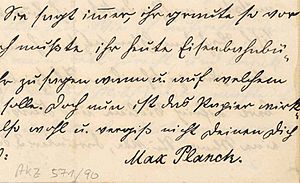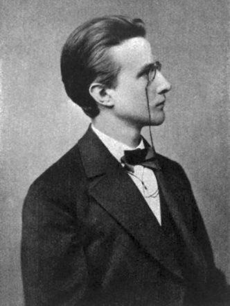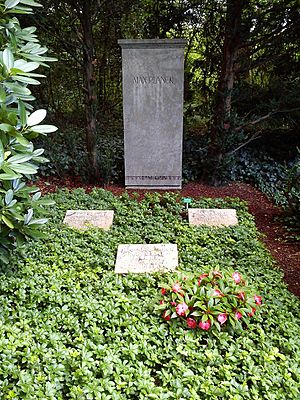Max Planck facts for kids
Quick facts for kids
Max Karl Planck
|
|
|---|---|
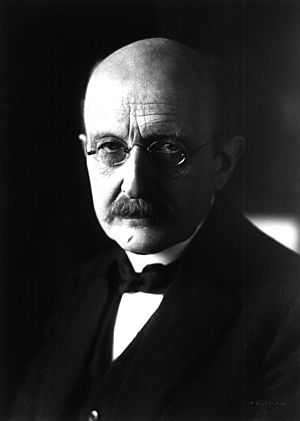
Planck in 1930
|
|
| Born |
Max Karl Ernst Ludwig Planck
23 April 1858 Kiel, Duchy of Holstein, German Confederation
|
| Died | 4 October 1947 (aged 89) |
| Education | University of Munich, (PhD, 1879) |
| Known for | See full List |
| Spouse(s) |
Marie Merck
(m. 1887; died 1909)Marga von Hösslin
(m. 1911) |
| Children | 5 |
| Awards |
|
| Scientific career | |
| Fields | Physics |
| Institutions |
|
| Thesis | Über den zweiten Hauptsatz der mechanischen Wärmetheorie (On the Second Principles of Mechanical Heat Theory) (1879) |
| Doctoral advisor |
|
| Doctoral students |
|
| Other notable students | |
| Signature | |
Max Karl Ernst Ludwig Planck (born April 23, 1858 – died October 4, 1947) was a German theoretical physicist. He is famous for discovering energy quanta. This groundbreaking work won him the Nobel Prize in Physics in 1918.
Planck made many important contributions to physics. His biggest achievement was creating quantum theory. This theory completely changed how we understand tiny particles like atoms. In 1948, a German science organization, the Kaiser Wilhelm Society, was renamed the Max Planck Society in his honor. Today, this society has many research centers.
Contents
Max Planck's Early Life and Education
Planck came from a family of smart and educated people. His great-grandfather and grandfather were university professors. His father was a law professor at the University of Kiel and Munich. One of his uncles was also a judge.
Max Planck was born in 1858 in Kiel, Germany. His birth name was Karl Ernst Ludwig Marx Planck. But by age ten, he started signing his name as Max and used it for the rest of his life.
He was the sixth child in his family. When he was young, there was often war. One of his first memories was seeing soldiers march into Kiel in 1864. In 1867, his family moved to Munich. Max went to the Maximilians gymnasium school. There, he met Hermann Müller, a math teacher who helped him learn about astronomy, mechanics, and mathematics. Müller taught him about the principle of conservation of energy. Planck finished school early, at age 17.
Planck was also very talented in music. He took singing lessons and played the piano, organ, and cello. He even wrote songs and operas. However, he chose to study physics instead of music.
In 1874, Planck started studying at the University of Munich. His physics professor, Philipp von Jolly, tried to tell him not to study physics. Jolly said, "Almost everything is already discovered in this field." But Planck replied that he just wanted to understand the basic ideas. He did some experiments on diffusion of hydrogen through heated platinum. But he soon switched to theoretical physics.
In 1877, he spent a year studying in Berlin. He learned from famous physicists Hermann von Helmholtz and Gustav Kirchhoff. He also studied the writings of Rudolf Clausius, which made him choose thermodynamics as his main area of study.
In 1879, Planck earned his PhD. His paper was about the second law of heat theory. He then briefly taught math and physics at his old school in Munich. By 1880, he had earned the two highest academic degrees in Europe.
Planck's Academic Journey
After getting his degrees, Planck became an unpaid lecturer in Munich. He continued his work on heat theory. He discovered many of the same ideas as Josiah Willard Gibbs without knowing it. Entropy, a concept from Clausius, was very important in his work.
In 1885, Planck became a professor at the University of Kiel. He continued to study entropy, especially how it applied to physical chemistry. He published his book Treatise on Thermodynamics in 1897.
In 1889, he became a full professor at the Friedrich-Wilhelms-Universität in Berlin. He stayed there until he retired in 1926. In 1909, he was invited to give lectures at Columbia University in New York City.
Planck's Family Life
In 1887, Planck married Marie Merck. They had four children: Karl, twins Emma and Grete, and Erwin. Their home in Berlin became a popular place for scientists to gather. Famous people like Albert Einstein, Otto Hahn, and Lise Meitner often visited. They would often play music together.
In 1909, Marie Planck died. In 1911, Planck married his second wife, Marga von Hoesslin. They had one son, Hermann.
During World War I, Planck faced great sadness. His oldest son, Karl, was killed in battle. His second son, Erwin, was captured. Both his daughters, Grete and Emma, died while giving birth. Planck handled these losses with great strength.
Later, during World War II, his son Erwin was involved in a plot against the government. He was sentenced to death and executed in 1945. This loss deeply affected Planck.
Teaching at Berlin University
As a professor in Berlin, Planck joined the local Physical Society. He later became president of the German Physical Society.
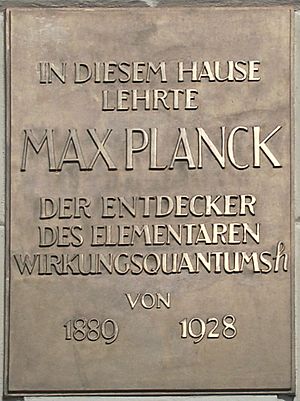
Planck taught a six-semester course on theoretical physics. Students described him as a great lecturer. He didn't have many graduate students, but some of them became very famous physicists:
The Birth of Quantum Theory
In 1894, Planck started studying black-body radiation. This was a problem about how light and heat are given off by hot objects. Scientists knew what happened in experiments, but they couldn't explain it with existing theories. Older theories worked for some parts of the problem but failed for others.
Planck worked hard on this problem. In 1900, he came up with a new idea. He suggested that energy is not given off smoothly. Instead, it comes in tiny, specific packets, or "quanta." He called these packets hν, where h is Planck's constant and ν is the frequency of the radiation.
At first, Planck thought this idea was just a mathematical trick. But it turned out to be a revolutionary concept. This idea was the beginning of quantum physics. It completely changed how scientists understood energy and matter. Because of this amazing discovery, Planck won the Nobel Prize in Physics in 1918.
Planck tried for years to fit his quantum idea back into older physics theories, but he couldn't. Other scientists also struggled with it. But Planck knew his constant h had a real, non-zero value.
The physicist Max Born said that Planck was a careful thinker. He wasn't someone who liked big, sudden changes. But his belief in facts was so strong that he announced the most revolutionary idea in physics.
Planck and Albert Einstein
In 1905, Albert Einstein published his famous papers. Planck was one of the first to see how important Einstein's special theory of relativity was. Thanks to Planck's influence, this theory was quickly accepted in Germany. Planck also helped to expand Einstein's theory.
At first, Planck didn't agree with Einstein's idea that light also comes in packets (which we now call photons). Planck didn't want to give up Maxwell's theory of electrodynamics. He felt it would set physics back centuries.
However, Einstein showed more evidence for his ideas. In 1911, Planck and Walther Nernst organized a meeting in Brussels. At this meeting, Einstein was able to convince Planck about light quanta.
Planck later helped Einstein get a professorship in Berlin in 1914. The two scientists became close friends and often played music together.
Life During World Wars
When World War I began, Planck, like many others, felt a sense of national pride. He even signed a public statement supporting the war. However, Einstein remained a pacifist.
After the war, Germany faced tough times. Planck, as a leading figure in German physics, encouraged his colleagues to "persevere and continue working." He helped create an organization to get financial support for scientific research in Germany.
Planck held many important positions. He was a leader at Berlin University, the Prussian Academy of Sciences, and the Kaiser Wilhelm Society.
Planck and the Nazi Era
When the Nazis came to power in 1933, Planck was 74 years old. He saw many Jewish friends and colleagues lose their jobs and be treated badly. Hundreds of scientists left Germany. Planck tried to help some Jewish scientists secretly continue their work. He also tried to talk to Adolf Hitler about the issue, but it didn't help.
Otto Hahn asked Planck to gather professors to speak out against the treatment of Jewish professors. But Planck believed it would only make things worse. He thought others would just take the jobs of those who spoke out.
In 1936, Planck's term as president of the Kaiser Wilhelm Society ended. The Nazi government pressured him not to seek another term.
Johannes Stark, a supporter of "German Physics" (which rejected Einstein's theories), attacked Planck and others for teaching Einstein's ideas. Stark called them "white Jews." The Nazi government even investigated Planck's family history.
In 1938, Planck turned 80. The German Physical Society celebrated his birthday. At the end of 1938, the Prussian Academy of Sciences was taken over by the Nazis. Planck resigned in protest. He continued to give public talks, including one on religion and science.
During World War II, Planck's home in Berlin was destroyed by air raids. He lost all his scientific notes and letters. In 1944, his son Erwin was arrested after being involved in a plot to assassinate Hitler. Erwin was executed in January 1945. This tragedy deeply affected Planck.
After the war, Planck moved to Göttingen. He died there on October 4, 1947. His grave is in the old City Cemetery in Göttingen.
Max Planck's Views on Religion
Planck was a member of the Lutheran Church in Germany. He was open-minded about different beliefs.
He gave a lecture in 1937 called "Religion and Natural Science." In it, he said that religious symbols are important for worshiping God. But he also warned that these symbols are not perfect ways to show God. He criticized atheists for making fun of symbols. He also warned believers not to value symbols too much.
Planck believed that God is everywhere. He thought that both science and religion fight against doubt and strict rules. Their goal, he said, is "toward God!"
In 1944, Planck said that after studying atoms, he believed there is no matter on its own. He thought all matter comes from a force that makes particles vibrate. He said, "We must assume behind this force the existence of a conscious and intelligent spirit. This spirit is the matrix of all matter."
Planck argued that the idea of God is important for both religion and science. He said, "For believers, God is in the beginning, and for physicists He is at the end of all considerations."
Historian John L. Heilbron said Planck's views on God were like deism. Planck once said he was deeply religious, but he didn't believe in a "personal God, let alone a Christian God."
Images for kids
-
Max Planck's marble bust at the Deutsches Museum in Munich
-
From left to right: W. Nernst, A. Einstein, Planck, R.A. Millikan and von Laue at a dinner given by von Laue in Berlin on 11 November 1931
See also
- Zero-point energy
- In Spanish: Max Planck para niños


